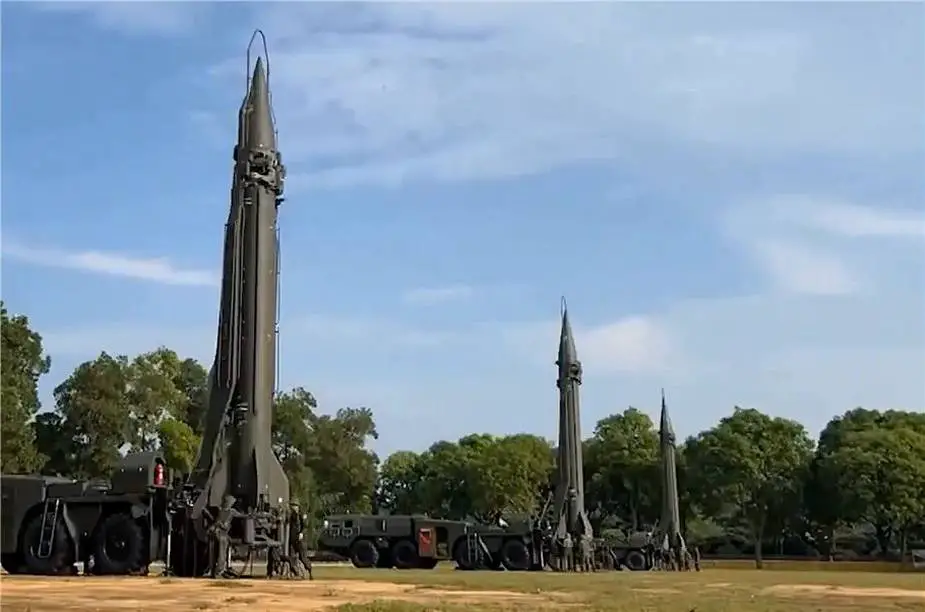Breaking news
Vietnam upgrades its Scud tactical ballistic missiles with foreign partners.
In a recently released video by the Vietnamese armed forces, the 490th Brigade of the Vietnam People's Army can be seen participating in a training exercise involving the deployment of Scud tactical ballistic missiles. Vietnam is currently working with international partners to enhance the capabilities of its Soviet-era Scud missile systems, focusing on extending their range and reducing the Circular Error Probable (CEP) to increase accuracy.
Follow Army Recognition on Google News at this link

Soldiers of the Vietnamese armed forces conduct drill exercise with modernized Scud ballistic missile systems. (Picture source Vietnamese army video footage)
The Vietnamese armed forces, also known as the Vietnam People's Army, have been reported to possess Scud B and Scud C short-range ballistic missiles. The Scud missiles were likely acquired from the Soviet Union or Russia, given their historical military relationship. According to our source, the Vietnamese armed forces have an undisclosed number of Soviet-made conventional 9K72/9K77 tactical ballistic missiles, NATO reporting names RS-SS-1C/D Scud B/C.
Although there is limited public information on the specific details of the Vietnamese Scud missile inventory, it is known that Vietnam has been focusing on modernizing its armed forces and improving its missile capabilities. The Scud missiles in the Vietnamese armed forces would provide a tactical ballistic missile capability that could be employed in various regional defense scenarios.
As with other countries that possess Scud missiles, the presence of these systems in Vietnam raises concerns due to their proliferation and potential to carry weapons of mass destruction. However, Vietnam has been participating in various international arms control and nonproliferation initiatives, which may mitigate some of these concerns.
The 9K72 missile, also known as the R-17 Elbrus or the Scud B, is a short-range, road-mobile, tactical ballistic missile system developed by the Soviet Union in the early 1960s. It was an improved version of the earlier R-11 (Scud A) missile system and was widely exported to various countries, including several in the Middle East, Asia and North Africa.
The 9K72 missile has a range of approximately 300 kilometers (186 miles) and can carry a variety of payloads, including conventional high-explosive, chemical, or nuclear warheads. It is powered by a single-stage, liquid-fueled rocket engine and uses an inertial guidance system, which makes it less accurate compared to more modern missile systems with GPS or other advanced guidance systems.
The Scud B missile became infamous during the 1991 Gulf War when Iraq, under Saddam Hussein, launched several of these missiles against coalition forces and Israel. Since then, the missile has been used in several other conflicts, such as the Yemeni Civil War and the Syrian Civil War.
Despite its age and relative inaccuracy, the 9K72 missile remains a significant threat due to its proliferation and potential to carry weapons of mass destruction. Efforts have been made to counter this threat through the development of missile defense systems like the United States Patriot and Israel's Iron Dome.
The Scud C is a short-range, road-mobile, tactical ballistic missile system developed by the Soviet Union as an evolution of the earlier Scud B (R-17 Elbrus) missile. It is a part of the Scud missile family, which includes Scud A (R-11), Scud B (R-17), and Scud D (R-17V).
The Scud C missile has an increased range compared to the Scud B, with a range of approximately 500-600 kilometers (310-373 miles). This extended range was achieved through improvements in the missile's fuel and oxidizer, a lighter warhead, and better aerodynamics. Similar to the Scud B, the Scud C can carry a variety of payloads, including conventional high-explosive, chemical, or nuclear warheads. It uses an inertial guidance system, which makes it less accurate than modern missile systems with GPS or other advanced guidance systems.
The Scud C was not as widely exported as the Scud B, but it has still been deployed by several countries, including Iran, North Korea, and Syria. The missile has been used in various conflicts and has posed a significant threat due to its proliferation and potential to carry weapons of mass destruction.
The Scud missile is mounted on a Transporter-Erector-Launcher (TEL) vehicle designed to transport, erect, and launch Scud missiles. The launcher vehicle plays a crucial role in the mobility, concealment, and rapid deployment of the Scud missile system.
The most common Scud missile launcher is the MAZ-543 8x8 truck or its later variant, the MAZ-7310, which are eight-wheeled, all-terrain vehicles developed in the Soviet Union. These vehicles are capable of carrying a single Scud missile in a horizontal position. When the launcher reaches its designated launch site, the missile is erected to a vertical position using a hydraulic system, and the launcher serves as a stable platform for the missile during the launch sequence.
The mobility of the Scud missile launcher enables it to avoid detection and targeting by enemy forces. After launching a missile, the TEL can quickly relocate to another location, reducing its vulnerability to counterattacks. This mobility and the ability to launch missiles with relatively short preparation time make Scud missile systems a challenging threat to counter.


























